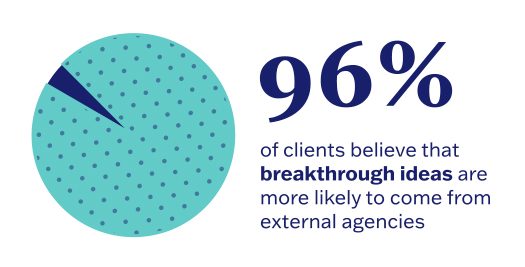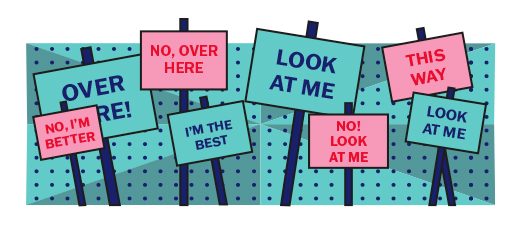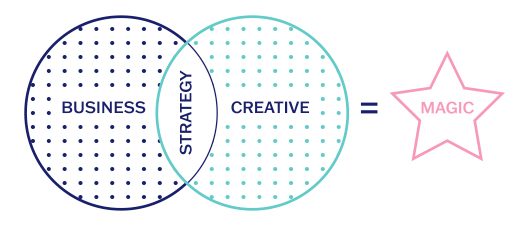We are here to inject art into commerce”
- Tibor Kalman, Graphic Designer
The difference between art and design is the purpose. While art is a matter of subjectivity, design is the art of problem solving. The purpose of design is not merely to make something look good, but to make it a success. It’s a commercial form of art. Whether it’s a new business looking to create a brand or an existing brand looking to create a fresh marketing campaign, there is a distinct commercial goal in mind with a desirable outcome. Regardless of the scope, a business is presenting a problem to be solved and there is a significant rising demand for creative solutions.

Sometimes people working in a business can become ingrained in their inner workings. Business owners focus on growth, sales reps on profit and marketing managers on awareness. There are many agendas at play trying to achieve different goals. However, the overarching goal is success and growth. People working together under one brand to achieve a specific mission. However, brands need to work harder than ever to be noticed and to resonate with consumers. Marketing may shout from the rooftops but if communication is not relevant or is confusing, consumers will swiftly move on. It has become imperative for brands to stand out from the crowd, break through the noise and find that point of differentiation in the market. Brands can no longer remain static. They must stay relevant and innovative to adapt to a fast-paced global economy. Marty Neumeier states that “the power has shifted from companies to customers.” People hate being sold to and the market is saturated with brands competing for their attention.

Authenticity is key. If brands can align with their target audience and speak to them at their level, people will become aware and identify with a brand that shares their sense of identity. From brand awareness, comes familiarity which can lead to loyalty. Consumers travel in tribes and tribes support one another. If a brand can tap into a tribe, there is no limit to its growth. Trends will naturally play a role and can cause shifts in the landscape. However, if a brand stays relevant and listens to its tribe, it can continue to adapt and overcome any adversity.
In this instance, a design strategy can be extremely valuable. Some might ask, what is design strategy? Why is it different to business or marketing strategy?
Design strategy defines the approach of a brand. Identifying its purpose, vision, mission, and personality. Discovering how it should sound, feel, and ultimately look. After all, a brand is not just aesthetics, “it’s a person’s gut feeling about a product, service or company.” (Marty Neumeier – Brand Master) There is a misconception that a brand is a suite of assets to make a company look a certain way. This is partially true. Brown Thomas will appear very differently to the likes of Primark. But they appear differently for an important reason. To evoke a feeling in their consumers. To feel luxurious, to feel happy, to feel empowered and most importantly, to feel part of a community. It creates a sense of belonging which is ultimately what people desire.
However, there are many misconceptions around brand strategy and its value.

It may seem like a strategic design approach will take longer and cost more. This is true. Businesses know what they want and designers should just make it happen, right?
Absolutely, designers can take a brief, digest the information provided and present a creative solution. Order driven design can be successful but what is it based on? Subjective opinions that seem like a good idea at the time? Solutions based on this approach have a weak foundation and risk failure with the target audience. It may become part of the noise and not land with consumers. As mentioned earlier, brands need to work harder than ever to reach their consumers and build a tribe.
For example, Tesla was founded in 2003. It entered a sea of well-established competitors in the auto industry. They needed to have a point of differentiation within the marketplace and create their own tribe. Tesla’s brand mission is ‘a commitment beyond their automotive market to accelerate the world’s transition to a sustainable energy’. Consumers have become increasingly aware of the climate crisis and are looking for solutions to tackle this global emergency. Tesla have positioned themselves to take advantage of this need and meet the demand. This is the power of strategic branding. Finding a niche and owning it.
Through in-depth discovery and research, business masterminds and marketing geniuses, who know their landscape inside out, can share their in-depth knowledge with design agencies. By understanding this landscape, design strategy can focus on the elements which are unique and define the brand approach. This valuable information will inform the game changing solutions that can emerge from sound strategy. If business objectives can align with a creative approach, the common goal of reaching the consumer and ensuring brand engagement can be achieved.

By investing in brand strategy, brands merge the best of both worlds. Business and design. This leads to a considered concept that is built on strategic creative thinking. By all parties coming to the table and getting to the root of the problem, it unifies perspectives and gets everyone on the same page. This saves valuable time in the long run as there is a clear framework to use as a reference. It will also determine the success of the project in a tangible format. By having metrics in place to measure the success of a project, the business can evaluate data to determine a result. This provides clarity from the beginning and sets the stage to create the desired brand experience. Strategy is the concrete block of business and design.
The shift in focus of design as a commodity to a truly value-based service is what differentiates TapCreative as a design partner. For us, effective and purposeful design is always grounded in strategy. It is the framework that allows us to make informed design decisions which shape the perceptions of our client’s audience and ultimately help them to achieve their objectives.
We can help your brand to do the same, delivering beyond design aesthetics, to thrive in this connected world we live in.
It all starts with a chat. So get in touch and let’s make the make the magic happen.
Elaine Merren
Senior Brand Designer